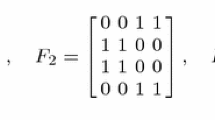Abstract
Using a strong definition of frequency hypercube, we define a strengthened form of orthogonality, called equiorthogonality, for sets of such hypercubes. We prove that the maximum possible number of mutually equiorthogonal frequency hypercubes (MEFH) of order n and dimension d based on m distinct symbols is (n-1)d/(m-1). A set of (n-1)d/(m-1) such MEFH is called a complete set. Because of the stronger conditions on the hypercubes, we can find complete sets of MEFH of all lower dimensions within any complete set of MEFH; this useful property is not shared by sets of mutually orthogonal hypercubes using the usual, weaker definition.
Similar content being viewed by others
References
R. C. Bose, On the application of the properties of Galois fields to the problem of construction of hyper-Graeco-Latin squares, Sankhya, Vol. 3 (1938) pp. 323-338.
R. C. Bose and K. A. Bush, Orthogonal arrays of strength two and three, Ann. Math. Statist., Vol. 23 (1952) pp. 508-524.
C.-S. Cheng, Orthogonal arrays with variable numbers of symbols, Ann. Statist., Vol. 8 (1980) pp. 447-453.
J. Dénes and A. D. Keedwell, Latin Squares and their Applications, Academic Press, New York (1974).
J. Dénes and A. D. Keedwell, Latin Squares, Annals of Discrete Math., Vol. 46, North-Holland, Amsterdam (1991).
W. T. Federer, On the existence and construction of a complete set of orthogonal F (4t; 2t, 2t)-squares design, Ann. Statist., Vol. 5 (1977) pp. 561-564.
A. Hedayat, D. Raghavarao, and E. Seiden, Further contributions to the theory of F-squares design, Ann. Statist., Vol. 3 (1975) pp. 712-716.
A. Hedayat and E. Seiden, F-square and orthogonal F-square designs: A generalization of latin square and orthogonal latin square designs, Ann. Math. Statist., Vol. 41 (1970) pp. 2035-2044.
P. Höhler, Eine Verallgemeinerung von orthogonalen lateinischen Quadraten auf höhere Dimensionen, Diss. Dokt. Math. Eidgenöss, Hochschule Zürich (1970).
K. Kishen, On the construction of latin and hyper-Graeco-Latin cubes and hypercubes, J. Indian Soc. Agriculatural Statist., Vol. 2 (1950) pp. 20-48.
C. F. Laywine, Complete sets of orthogonal frequency squares and affine resolvable designs, Utilitas Math., Vol. 43 (1993) pp. 161-170.
C. F. Laywine and G. L. Mullen, Generalizations of Bose's equivalence between complete sets of mutually orthogonal latin squares and affine planes, J. Combin. Theory, Series A, Vol. 61 (1992) pp. 13-35.
J. P. Mandeli, F.-C. H. Lee, and W. T. Federer, On the construction of orthogonal F-squares of order nfrom an orthogonal array (n, k, s, 2) and an OL(s, t) set, J. Statist. Plann. and Inf., Vol. 5 (1981) pp. 267-272.
I. H. Morgan, Construction of complete sets of mutually equiorthogonal frequency hypercubes, Discrete Math., to appear.
G. L. Mullen, Polynomial representation of complete sets of frequency squares of prime power order, Discrete Math., Vol. 69 (1988) pp. 79-84.
C. R. Rao, Some combinatorial problems of arrays and applications to design of experiments, in A Survey of Combinatorial Theory, J. N. Srivastava (ed.), North-Holland, Amsterdam (1973) pp. 349-359.
S. J. Suchower, Nonisomorphic complete sets of F-rectangles with prime power dimensions, Designs, Codes and Cryptography, Vol. 5 (1995) pp. 155-174.
S. J. Suchower, Polynomial representations of complete sets of frequency hyperrectangles with prime power dimensions, J. Combin. Theory, Series A, Vol. 62 (1993) pp. 46-65.
Author information
Authors and Affiliations
Rights and permissions
About this article
Cite this article
Morgan, I.H. Equiorthogonal Frequency Hypercubes: Preliminary Theory. Designs, Codes and Cryptography 13, 177–185 (1998). https://doi.org/10.1023/A:1008282513875
Issue Date:
DOI: https://doi.org/10.1023/A:1008282513875




